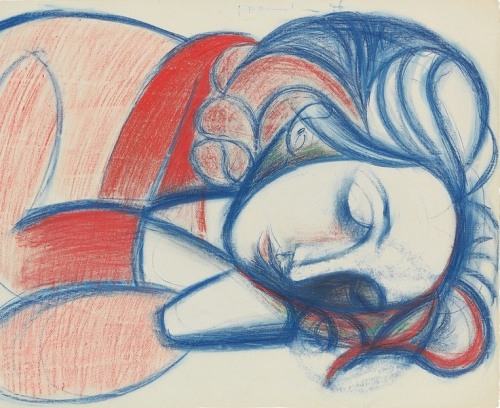

NEW YORK
Pablo Picasso
ACQUAVELLA GALLERIES
18 East 79th Street (Between Madison and Fifth Avenues)
October 7–December 3, 2021
More than eighty works appear in “Picasso: Seven Decades of Drawing,” an exhibition deftly curated by art historian Olivier Berggruen. This presentation shows how drawing was Pablo Picasso’s id and ego, a crucial extension of self—or perhaps more accurately, obsession—that served a purpose far beyond the merely preparatory.
Picasso’s behavior was often monstrous and caused many of his wives and mistresses a great deal of suffering. Yet his Portrait de femme endormie, III (Portrait of Sleeping Woman, III), 1946—an intimate crayon drawing in red, blue, and green of his much younger lover the artist Françoise Gilot, who birthed two of his children—displays, through fluid line and elegant form, a remarkable tenderness. By contrast, Dora Maar dans un fauteuil d'osier (Dora Maar in a Wicker Chair), 1938, is an impersonal, cubistic depiction of Picasso’s longtime companion in ink, charcoal, and pastel. The piece’s elaborate yet manic line work suggests a strange kind of indifference to his subject, turning Maar into something alien, detached.
The sanguine-on-paper Le taureau (The Bull), 1949, is a high-contrast contour drawing of the titular subject, executed with a powerful, assured line. The animal’s stylized rendering is sophisticated, yet it still manages to feel primeval, elemental, as though the source of its spirit could be found in the caves of Lascaux. The visible erasures from a preliminary image give the viewer a chance to better understand how Picasso might have arrived at this final form. Picasso frequently used the bull as a symbol to represent himself, and the bloody spectacle of Scène tauromachique (Bullfighting Scene), 1900, which shows the creature impaled by swords, makes us wonder what his state of mind was when he created this picture. However, a pencil self-portrait, Tête (Head), 1972, made about a year before the artist died, seems more fraught and psychologically straightforward. With a penetrating, anxious line, Picasso depicts himself as a misshapen, terrified being who might disintegrate at any moment. It is a simple work that, nevertheless, offers up a profound statement on life near its end.